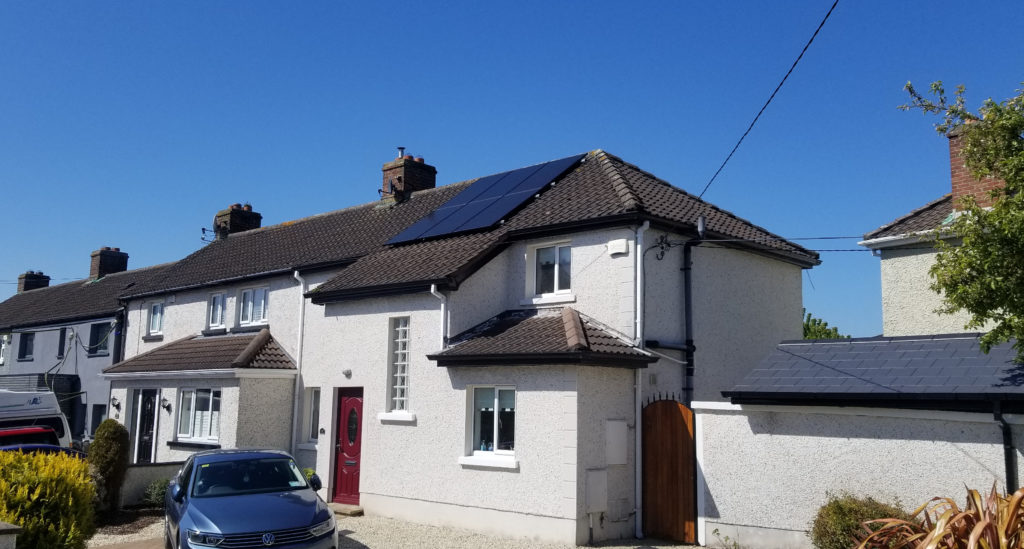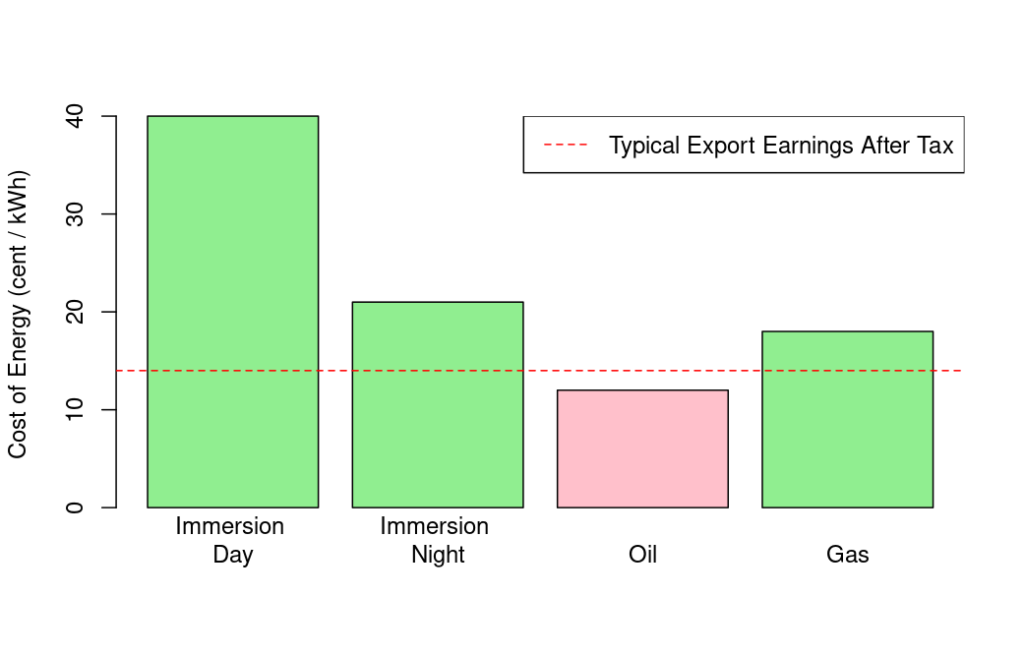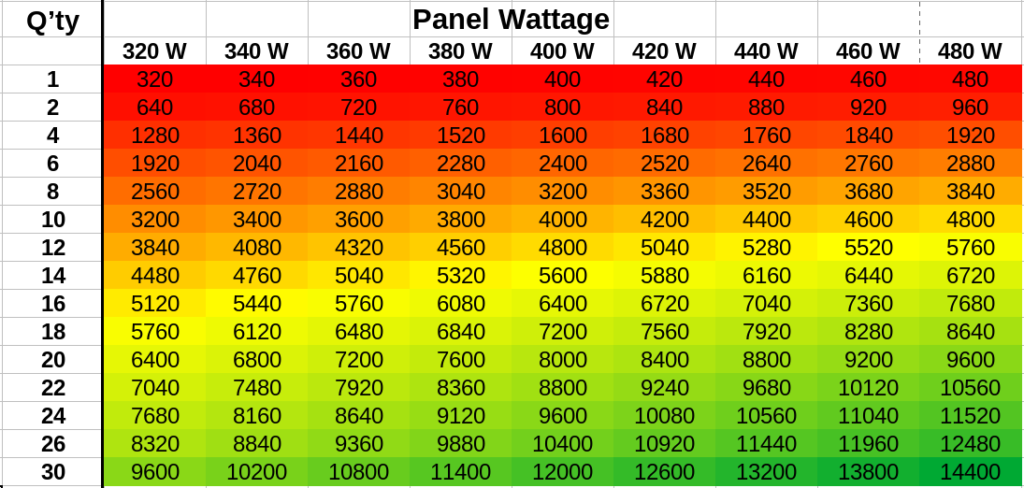The number of solar panels you need depends on your goal: Want to save some money on electricity? Cut your bills to zero? Sell electricity to the grid?
Let’s go through the options to see how many panels you need for each. Plus, my personal recommendation, based on the financially optimal number of panels.
I’ll assume typical electricity consumption (4,200 kWh per household per year). I’ll also assume 400 W panels – a common size.
How many solar panels to put a dent in your bills
Say you want to reduce your bills by a few hundred Euros per year…
Basically, you’ll need to:
- Supply a good chunk of your daytime electricity use with solar
- Sell a handful of kWhs to the grid during the summer for extra income
For the average household, you’ll need 6 solar panels to put a decent dent in your bills. This will generate around 2,100 kWh per year, or half your electricity needs. But your bills won’t quite fall by half. This is mainly because solar won’t affect your standing charge.

How many solar panels to radically reduce your bills
Say you want to reduce your bills by 70%…
You could achieve that purely with solar electricity for your own consumption. But a balance between supplying electricity for yourself and selling electricity to the grid will be much more practical (and cost-effective). That’s because your solar panels will supply much more than 70% of your electricity need during summer, and much less during winter.
So here’s my suggestion:
- Aim to supply most of your daytime electricity needs from the solar panels
- Install a power diverter for water heating by solar energy
- Add some extra panels for electricity to sell to the grid. The money you make from selling electricity to the grid will help offset your standing charge and imports.
A lot of people would add a battery, too. And that’s not a bad idea. But extra solar panels generally give a higher return on investment than a battery. Although if you want blackout protection, then a battery is essential.
Also, make sure to consider a day/night electricity tariff. With lots of solar, most of your electricity consumption from the grid will be at night. So lower-cost night units will make a big difference.
Panels-wise, the typical household will need around 16 panels to reduce their bill by 70%. As a reminder, day/night tariffs or time-of-use metering will be near-essential to reaching this level of savings.
And by the way, at this point a household will already be generating more electricity than they consume (5750 produced vs 4200 consumed). So from the environmental point of view, this puts you solidly into the “net electricity positive” category.
How many solar panels to eliminate your bills and make money
What if you could earn more money by selling electricity to the grid than you pay for electricity in an entire year? And have your electricity supplier send you a cheque… It’s possible, but it will take a lot of solar panels. Mainly because you not only have to offset your electricity consumption, but also standing charges and tax on your electricity export earnings.
An Irish household with typical electricity consumption will need 9 kW of solar panels. They will also need to
- Get on a day/night or time-of-use electricity tariff
- Shop around for a high export payment for solar
- Get a power diverter and/or battery
Follow these steps, and you can just about do better than break-even. So you will be an overall beneficiary from your electricity supplier to the tune of maybe €100 per year.
If you’re seeking a challenge, and want your electricity supplier to pay for your annual holiday, you’ll need to:
- Install more than 10 kW of panels (here’s how)
- Conserve electricity to achieve below-average electricity consumption
What’s the ideal number of solar panels, financially? (EnergyD’s Recommendation)
At EnergyD, we ran the numbers on the ideal number of panels, and have shared the results below.
Assumptions:
- No batteries, power diverters, or other storage
- €0.40 daytime electricity unit rate
- €0.20 earned per unit exported (pre-tax)
- 30% marginal tax rate on exported units (above the €200 free exemption)
- After-grant installation costs as shown in the table
- Annual electricity consumption of 4,200 kWh
- Conservative on-site electricity consumption percentages come from our other in-house research
Results:

It turns out that any system size between 2 kW and 9 kW performs well financially. But the highest percentage returns were with a system size of about 7kW. This corresponds to a sweet spot of around 18 panels. Of course, the overall return in €/year keeps going up and up as you add more panels.
There are nuances to every case though. Here’s how different circumstances can affect the sweet spot for solar percentage returns:
| Adding a power diverter or battery | More panels |
| You mostly run power-hungry appliances during daylight hours | More panels |
| High electricity consumption | More panels |
| Low electricity consumption | Fewer panels |
| Low tax band | More panels |
| High tax band | Fewer panels |
Practical limits on the number of panels
Spreadsheets are not constrained by roof space. But reality is. Indeed, most Irish households have space for only 2-5 kW of panels on their roof. Plus, the upfront cost of 18 panels may put them out of reach for many people. So in many cases, the best number of solar panels is whatever your roof space and wallet allow.
What about power diverters?
Power diverters can make financial sense when diverted power is worth more to you than exported power.
Example: Let’s say diverted power heats water that would otherwise be heated using day-rate electricity through an immersion heater. There’s potential to divert 2,000 units per year. Your export payment is €0.20 per kWh. And your tax rate is 30%.
- Diverted power will be worth €0.40 per unit (electricity day rate)
- Exported power will be worth €0.14 per unit (after tax)
- Diverting 2000 units per year will be worth €280
In this case, installing a power diverter makes great financial sense as it will provide an additional €280 per year in benefits (for an up-front cost of around €650). However, the benefits of diverting electricity are smaller if you currently heat water using gas or night-rate electricity. And given current electricity and oil prices, it actually makes more sense to export your electricity than to divert it if you can use oil directly for water heating. On the other hand, many oil central heating systems only let you heat water in conjunction with all your radiators. In which case a power diverter can still make sense.

What about solar batteries?
Batteries don’t currently make much sense financially. There are two reasons for this:
- It takes thousands of cycles for a battery to pay for itself, by which time the warranty will be running out
- Solar export payments and night rate electricity prices are about the same. So instead of using a battery, you can just sell your surplus during the day and buy it back for about the same price at night
However, batteries can a make a lot of sense for non-financial reasons. Specifically, a battery is essential if you want blackout protection (so you still have electricity while the grid is down).
Number of solar panels vs kilowatts of solar panels
As a closing note, people like to talk about the number of panels. But what’s more important is the total power of their solar panels. You get this by multiplying the number of solar panels by the power of each panel.
Example 2: 11 panels of 400 Watts each = 4,400 Watts
Example 2: 10 panels of 440 Watts each = 4,400 Watts
Which is more powerful – Example 1 or Example 2? Actually, there’s no difference. Because it’s the total Wattage that really counts (see the chart below)
Total wattage by panel wattage and quantity

